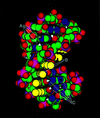The solution structure of a DNA*RNA duplex containing 5-propynyl U and C; comparison with 5-Me modifications
- PMID: 12736318
- PMCID: PMC156038
- DOI: 10.1093/nar/gkg356
The solution structure of a DNA*RNA duplex containing 5-propynyl U and C; comparison with 5-Me modifications
Abstract
The addition of the propynyl group at the 5 position of pyrimidine nucleotides is highly stabilising. We have determined the thermodynamic stability of the DNA.RNA hybrid r(GAAGAGAAGC)*d(GC(p)U(p)U(p)C(p)U(p) C(p)U(p)U(p)C) where p is the propynyl group at the 5 position and compared it with that of the unmodified duplex and the effects of methyl substitutions. The incorporation of the propyne group at the 5 position gives rise to a very large stabilisation of the hybrid duplex compared with the analogous 5-Me modification. The duplexes have been characterised by gel electrophoresis and NMR spectroscopy, which indicate that methyl substitutions have a smaller influence on local and global conformation than the propynyl groups. The increased NMR spectral dispersion of the propyne-modified duplex allowed a larger number of experimental restraints to be measured. Restrained molecular dynamics in a fully solvated system showed that the propyne modification leads to substantial conformational rearrangements stabilising a more A-like structure. The propynyl groups occupy a large part of the major groove and make favourable van der Waals interactions with their nearest neighbours and the atoms of the rings. This enhanced overlap may account at least in part for the increased thermodynamic stability. Furthermore, the simulations show a spine of hydration in the major groove as well as in the minor groove involving the RNA hydroxyl groups.
Figures






Similar articles
-
The solution structure of [d(CGC)r(aaa)d(TTTGCG)](2): hybrid junctions flanked by DNA duplexes.Nucleic Acids Res. 2000 Mar 15;28(6):1322-31. doi: 10.1093/nar/28.6.1322. Nucleic Acids Res. 2000. PMID: 10684926 Free PMC article.
-
Solution structure of DNA/RNA hybrid duplex with C8-propynyl 2'-deoxyadenosine modifications: Implication of RNase H and DNA/RNA duplex interaction.Biochim Biophys Acta. 2007 Jan;1769(1):20-8. doi: 10.1016/j.bbaexp.2006.11.004. Epub 2006 Nov 16. Biochim Biophys Acta. 2007. PMID: 17196678
-
Solution structures of DNA.RNA hybrids with purine-rich and pyrimidine-rich strands: comparison with the homologous DNA and RNA duplexes.Biochemistry. 1998 Jan 6;37(1):73-80. doi: 10.1021/bi9719713. Biochemistry. 1998. PMID: 9425027
-
Gel electrophoresis and the structure of RNA molecules.Biotechnol Genet Eng Rev. 1992;10:379-401. doi: 10.1080/02648725.1992.10647893. Biotechnol Genet Eng Rev. 1992. PMID: 1284511 Review. No abstract available.
-
Nucleic acids: theory and computer simulation, Y2K.Curr Opin Struct Biol. 2000 Apr;10(2):182-96. doi: 10.1016/s0959-440x(00)00076-2. Curr Opin Struct Biol. 2000. PMID: 10753816 Review.
Cited by
-
Refinement of the AMBER force field for nucleic acids: improving the description of alpha/gamma conformers.Biophys J. 2007 Jun 1;92(11):3817-29. doi: 10.1529/biophysj.106.097782. Epub 2007 Mar 9. Biophys J. 2007. PMID: 17351000 Free PMC article.
-
2'-Alkynyl spin-labelling is a minimally perturbing tool for DNA structural analysis.Nucleic Acids Res. 2020 Apr 6;48(6):2830-2840. doi: 10.1093/nar/gkaa086. Nucleic Acids Res. 2020. PMID: 32052020 Free PMC article.
-
Thermostability, Tunability, and Tenacity of RNA as Rubbery Anionic Polymeric Materials in Nanotechnology and Nanomedicine-Specific Cancer Targeting with Undetectable Toxicity.Chem Rev. 2021 Jul 14;121(13):7398-7467. doi: 10.1021/acs.chemrev.1c00009. Epub 2021 May 26. Chem Rev. 2021. PMID: 34038115 Free PMC article. Review.
-
Chimeric RNase H-competent oligonucleotides directed to the HIV-1 Rev response element.Bioorg Med Chem. 2007 Aug 15;15(16):5386-95. doi: 10.1016/j.bmc.2007.05.066. Epub 2007 Jun 2. Bioorg Med Chem. 2007. PMID: 17566743 Free PMC article.
-
Atomic detail investigation of the structure and dynamics of DNA.RNA hybrids: a molecular dynamics study.J Phys Chem B. 2008 Feb 7;112(5):1515-24. doi: 10.1021/jp709827m. Epub 2008 Jan 16. J Phys Chem B. 2008. PMID: 18197661 Free PMC article.
References
-
- Dagle J.M. and Weeks,D.L. (2001) Oligonucleotide-based strategies to reduce gene expression. Differentiation, 69, 75–82. - PubMed
-
- Read M.L. and Bremner,K.H. (2002) Antisense strategies and non-viral gene therapy for cancer. Expert Opin. Ther. Pat., 12, 379–391.
-
- Zinker B.A., Rondinone,C.M., Trevillyan,J.M, Gum,R.J., Clampit,J.E., Waring,J.F., Xie,N., Wilcox,D., Jacobson,P., Frost,L. et al. (2002) PTP1B antisense oligonucleotide lowers PTP1B protein, normalizes blood glucose and improves insulin sensitivity in diabetic mice. Proc. Natl Acad. Sci. USA, 99, 11357–11362. - PMC - PubMed
-
- Hall K.B. and McLaughlin,L.W. (1991) Thermodynamic and structural properties of pentamer DNA.RNA, RNA.RNA and DNA.DNA duplexes of identical sequence. Biochemistry, 30, 10606–10613. - PubMed
-
- Lesnick E.A. and Freier,S.M. (1995) Relative thermodynamic stability of DNA, RNA and DNA:RNA hybrid duplexes: relationship with base composition and structure. Biochemistry, 34, 10807–10815. - PubMed
Publication types
MeSH terms
Substances
Associated data
- Actions
LinkOut - more resources
Full Text Sources
Other Literature Sources
Miscellaneous

